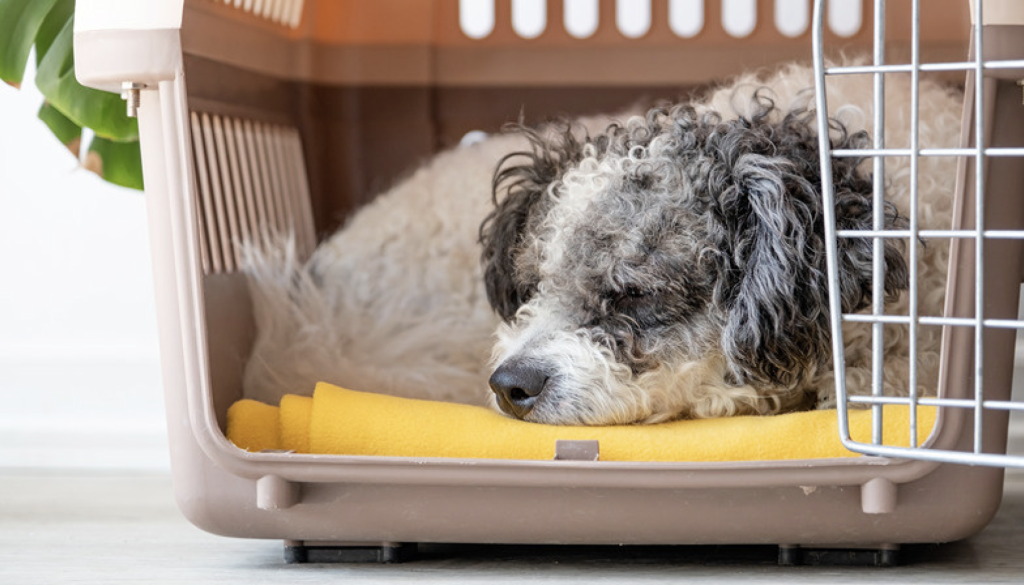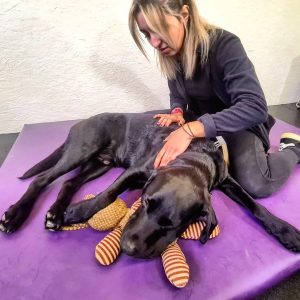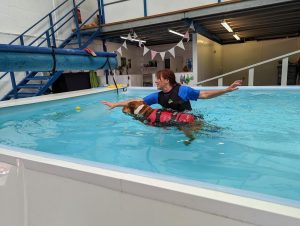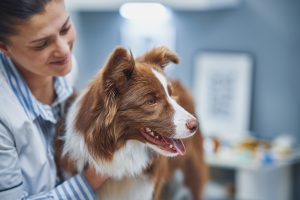Does your home promote your dog’s healing and health? Or does it perhaps predispose your dog to further injury, or delay their healing from injury? Let’s discuss the simple adaptations you can make to your home to help your dog heal and live their best, pain-free lives.
When environmental adaptations are necessary
While certain environmental adaptations benefit all dogs, we need to pay special attention to preparing our home when our dog has been injured, is recovering from surgery, or develops arthritis.
When we know and understand this, we can start to incorporate small changes into our homes while our precious pet is still young, to support them as they age. Minor changes can reduce the impact of arthritis and ensure a long and happy life for our dogs.
Short Term
Short-term adaptations are those we make when a dog requires a period of rest after an acute injury or surgery. We’ll look at the following areas:
- Safe, restricted activity: crates and alternatives.
- Finding the best position in the house: flooring, household activity, and more.
- Providing physical support: harnesses, leash walking, and alternatives.
- Providing mental stimulation: games, exercises, and mental exhaustion.
- The best bed: shape, size, position and alternatives.
Long Term
Long-term adaptations are those we make to reduce the impact of arthritis through home modifications, which will also reduce the risk of future injury in
your dog. We’ll look at the following areas:
- Flooring: slipping and associated risks, and low-slip alternatives
- Stairways indoors and outdoors: reducing the impact of stairs
- Doorways: possible risks and injury
- Furniture: safe, comfortable adaptations
- Toileting: access to the outdoors and considerations with age
- Social interaction: the impact on health and risks involved
Short-term adaptations for recovery from injury
When recovering from an acute injury or surgery, your dog may need to go through a period of restricted activity that includes crate rest. With a few simple tricks, this rest period can be easily managed.
Safe Restricted Activity
Your vet may have prescribed crate rest for your dog after surgery or an injury. Crate rest is the equivalent of bed rest for us, and allows us to protect our dog from further injury while they are healing. A crate is essentially a large metal cage with bars on the sides and a roof, or solid plastic ‘house’. Crate rest is usually recommended after:
- an amputation
- intervertebral disc disease surgery
- the fracture of a bone
- an orthopaedic or soft tissue surgery
It may also form part of conservative management of any condition, such as a torn cruciate ligament. If your dog is already crate trained and benefits from the safety and comfort provided by their crate, then this will be a simple inclusion for you. If you do not own a crate and have never considered crate training before, you might consider it now.
A crate can be a wonderful addition to your home, for both you and your dog. When the crate is introduced correctly, so that your dog sees it as an interesting and not threatening space, it can become their very own haven of safety and rest. A crate is particularly useful when you have to be away for an extended period, or when a house sitter moves into the home, giving your dog a familiar and private space to retreat to.
Choosing the right crate
Crates come in many sizes and materials. The best crate for you and your dog depends on your home and needs. You will want to select a crate that allows your dog to stand, sit, turn around, stretch, and lie stretched out comfortably. There needs to be enough space for a water bowl and chew toys as well. For successful adaptation to the crate, measure your dog’s length from hindquarters to nose, and their height from the floor to the highest point of their back or head. Anxious dogs will benefit from a slightly smaller crate than their length, while more active dogs will benefit from a few extra inches at either end.
Crates are commonly made from metal, or solid plastic. Metal bars allow the dog to see everything in their environment, while solid plastic will restrict their ability to see and engage with the environment outside the crate.
More anxious dogs will generally benefit from less visibility, while more active dogs may benefit from the mental stimulation of engaging with and observing their environment. Once you have a crate, set it up with a non-slip mat, a comfortable bed and blanket, a water bowl and some of your dog’s favourite toys.
Introducing your dog to a crate
Introduce your dog to the crate before they need to go onto crate rest, if at all possible. Do this in a series of small steps, rather than expecting your dog to enter and lie down comfortably at first introduction. Start by placing the crate in an area of the home where the family spends time, such as the lounge, in the same place as their usual sleeping spot in that room. Put a comfortable bed in the crate, and leave it open to allow them to explore it with no expectations. If they prefer to ignore it, that is fine.
Next, start to intentionally show them the crate, encouraging them with your voice and dog treats to come near it. Once they are comfortable, drop a few treats just inside the crate. As they become more comfortable and confident, drop treats deeper into the crate until they go all the way in. Continue to do this until they confidently go all the way into the crate to get the food, with no hesitation or uncertainty. This can happen within a few minutes, or over the course of a few days – go at your dog’s pace.
Start to feed your dog’s meals near or inside the crate. If they are completely comfortable going into the crate for treats or on their own, go ahead and place their meal inside. If they are still hesitant, place their food outside the crate.
Once they are comfortable, you can start to close the door of the crate while they are eating their meal. Immediately open the door once they are done eating on the first day, and with each subsequent meal gradually increase the time that the door remains closed. You want to watch your dog closely to make sure that they don’t show any signs of fear or anxiety during this process.
At this point, you can start to teach them a cue to enter the crate, as well as increasing the time that they remain in the crate with and without you in the room. Repeating the process of asking them to enter the crate, closing it, waiting for them to relax and then opening it again several times a day will quickly increase their confidence in the crate and help them to feel safe in that space.
You can progressively leave your dog in the crate for longer periods, until you are able to leave them while you leave the house, and overnight.

When you can’t introduce a crate over time
If you don’t have the opportunity to introduce your dog to the crate gradually before their surgery, they can still transition to the crate with minimal stress. Where you place the crate can make a big difference – we’ll consider this in the next section.
Create a predictable routine for your dog as they recover, including frequent breaks from the cage.
A routine can help you remember what to do and when, on a daily basis, such as giving medications, doing rehabilitation exercises, taking your dog for potty breaks, and meals. When out of their crate, your dog should always be on a lead with a harness. Always return your dog to their crate with a reward and encouragement.
Food-dispensing toys such as Kongs can be a great addition to the crate to alleviate boredom and encourage chewing and a positive association with the crate.
The best position in the house
As you consider the best space for your dog, think about where you will be during the day. If you work from home, a crate next to your desk or in the room where you work would be perfect, as you will be able to monitor their movement and activity continuously.
Think about how you and your dog will access their safe space. The pathway from their resting space to outside should be short and easy to navigate. Avoid stairs, slippery floors, and passageways that are too narrow for you to provide your dog with physical support.
Consider the daily activity and traffic in your home, and how your dog responds to it. For example, does your dog love to lie by a window and look out at the street or garden? If so, placing their bed or crate where they can look out is the considerate thing to do – for a calm dog. If your dog tends to get excited when they see activity outside, positioning them away from the window would be best, ensuring that they remain restful throughout the day. If you or someone else is home in the day, can the crate be placed in a position where the dog will be physically close to you? By simply placing your dog’s bed or crate in a spot in the home where they will be happiest, you can significantly reduce anxiety during their rest period. The ideal spot will depend on your home and your dog.
Lastly, think carefully about flooring. The slippery surface of most wood, laminate, or tiled flooring is not suitable, as it can cause dogs to slip and their legs to splay out. If this is your home, consider placing carpets, runners or yoga mats on the floor to provide traction for your dog as they walk.
Alternatives to a crate
If your dog is small and calm, a playpen with an open top could double as a crate. This gives your dog slightly more space than a crate, and allows you to lift them up and carry them, instead of asking them to enter and exit the crate through a door. Room rest is another alternative for dogs that don’t need to be as closely restricted. A resting room needs to have non-slip flooring, a comfortable bed, and no furniture that the dog will try to jump on or off of.
Providing physical support
If your dog is on activity restriction or crate rest, a well-fitting harness and lead should be used any time your dog is outside of the crate. The correct harness can provide you with a way to support your dog’s weight when they are in pain, and allows you to keep them stable and safe while they are regaining their footing.
A well-fitted Y-harness is recommended, as it provides a strap on the back that can be used as a handle and clears the shoulders for free movement.
Depending on your dog’s injury and their ability, you may want to provide additional support such as a hindquarter sling.
Providing mental stimulation
Mental stimulation can replace physical stimulation in situations of rest, and can be an effective way to mop up excess canine energy, leaving your dog exhausted and ready to sleep, even with little to no physical exertion. The best part about brain games is that they are incredibly fun and rewarding for both you and your dog. Let’s go though some ways that you can engage your dog’s mind – at all times, but especially during recovery when other options are closed.
Environment
Your dog’s physical environment can provide them with a great deal of mental stimulation during the course of the day. Placing their crate or bed in an area where they can be with you throughout the day, or in a central position in the house where they can watch the comings and goings of family members, or at a window where they can watch outside activity, will help to keep their interest during the day.
Food and food puzzles
Mealtimes can offer a wonderful opportunity for stimulation for your dog. Meals can be split into several smaller meals through the course of the day, presented in a food puzzle, a snuffle mat, a slow-release food toy, or as part of a simple training exercise. You could vary the ways in which you feed your dog – for instance, food portions can be frozen in ice balls or blocks during hot weather, requiring your dog to slowly lick the food out of the ice. There are many home-made puzzle options available, such as an egg carton or muffin tray containing small portions of food, with tennis balls blocking the openings. Your dog will have to figure out how to remove the blockage and reach the food, and will find the stimulation enjoyable. There are also many food puzzles on the market that range from easy to challenging. Food puzzles may become a favourite in your household!
Training Games
You can also use small meal portions to play simple training games with your dog. For example, begin training your dog to target your hand or a tennis ball with their nose, or to target a hand or block with their feet. The benefit of targeting is that you can start by simply establishing the behaviour in the first two weeks of recovery, and progress to basing your dog’s rehab exercises on targeting in the weeks that follow. This makes your dog an absolute partner in the healing process, provides you with a great way to track and measure their ability and motivation, and it is mentally
challenging and exhausting!
Nose work is another great way to include your dog’s instinct to sniff in the provision of both food and mental stimulation. If you have any interest in tracking, this is a great time to teach it to your dog. Nose work in your garden or backyard can be used during potty breaks, providing your dog with some purpose and enjoyment when they are in the yard
The best bed
A comfortable bed is essential. Make sure your dog’s bed is easy to get into and out of, and is supportive and comfortable. You will want a bed that is flat, even, and relatively firm. An orthopedic bed is highly recommended, especially for heavy dogs, or dogs with arthritis. They are an investment that your dog will benefit from for the rest of their lives.
While we tend to think that a soft bed is most comfortable, for a dog that has an orthopedic condition or any physical challenges a soft bed can make it much harder for them to get up out of their bed, or to lie down. A mattress material that is firmer and flat allows them to get on and off without losing their balance or battling against the cushioning of the bed.
A bed that is raised a few centimeters off the ground also has many benefits. It is easier for them to get on and off of the bed, and it provides better insulation from the floor resulting in a warmer bed.
Place a non-slip mat underneath and around their bed to ensure that the bed doesn’t slip when they are getting on or off, and that they can place their feet on a non-slip surface when they are getting up from the bed to prevent slipping.
Long-term adaptations to prevent injuries and encourage longevity
When our dogs suffer from chronic degenerative conditions such as arthritis or neurological degeneration, simple adaptations to our home environment can help to reduce anxiety, prevent injuries, and slow the progression of their disease.
This process should start with an intentional observation of your dog within your home environment. Take note of how they navigate through the space and whether they seem anxious or afraid at any point. Can you identify any areas that might increase the risk of injury, such as doorways where they tend to turn too quickly, floors where they slip, and obstacles they tend to trip over?
Flooring
Our most common flooring types today are also those that cause endless difficulties to our dogs! These include laminated, tiled and wooden floors. These surfaces provide little or no traction for the dog, and can cause them to slip, so that their legs splay out dangerously. Repetitive slipping on floors can inflame painful joints and cause injury to the soft tissues that surround those joints, further worsening arthritis. If you are not sure whether your floors bother your dog, watch how they walk in the house – are they hesitant or afraid, is there a change in their posture on slippery floors, such as a more crouched and stilted gait? Have you seen them slip on the floor before, and if so, where? Two aspects determine whether your dog slips on the floor – the flooring material and their paws. You can reduce slipping by paying attention to both aspects.
Stairways
For dogs with arthritis or degenerative conditions, stairways should be avoided, or controlled if they cannot be avoided. If stairways are a must, they should have a non-slip surface – for wooden, laminated or tiled stairways, add non-slip flooring tape to each step. This is important, even if you are using some of the other options shared above, to prevent slipping. Small dogs should be carried up and down stairs, while large dogs should be supported as they navigate the stairway with a harness such as the Help ‘Em Up harness or an alternative. Control access to the stairway with a baby gate, and minimize the amount of times your dog needs to travel up and down the stairs as much as possible.
Doorways
Doorways can pose a challenge when they require turning a sharp corner over a slippery surface, especially when your dog wants to move through them at speed. Consider when your dog rushes to get outside, or to the front door when the doorbell rings – which doorways are the biggest challenge? Thresholds or split levels that include a step up or down across different indoor and outdoor surfaces can be just as challenging. Ensure that surfaces are non-slip, and that height differences are minimized as much as possible with an in-between step or a ramp.
Furniture
Many of us love having our dogs lie on our bed or snuggle on the couch with us – and they love it, too. Sharing a cosy space is an important part of the bond we enjoy with our dogs. So we want keep up this aspect for as long as possible. However, dogs with arthritis or degenerative conditions should not be allowed to jump on and off furniture, as the impact of jumping can cause additional damage to their joints. Furniture ramps or steps are easily accessible and should be used in these cases. To be really proactive, teach smaller dogs from a young age not to jump on and off of furniture, but to be picked up or use their access ramps, instead. Access to furniture should be restricted when your dog is alone. As they start to struggle more to get on an off of furniture, try to provide them with assistance to prevent falls, slipping and injury.
Social Interaction
Social interaction is hugely important for your dog, but if they are in chronic pain, normal interactions may become more difficult. Pain often leads to a need to protect themselves, so that they become anxious and afraid, and potentially more reactive around other dogs. You can help them to continue to interact with other dogs in the home and outside the home in a positive way, without isolating them completely. Here are a two things you can do.
Feed Them Separately
Feeding time can be stressful in multi-dog households. Offer your compromised dog food in a separate room or space, away from other dogs so that they can eat slowly and at their own pace, without the feeling of competition or resource guarding.
Protect Playtimes
If you have dogs of different ages, their energy levels and play styles may be dramatically different. Your young dog will probably want to play roughly, while the older dog is unable to do so. Try to meet each of their play needs separately, instead of requiring that they play only with one another. Engage in each of their favourite games separately. This will allow your younger dog/s to expend their playful energy without aggravating your older dog. Supervise play times and help them to regulate around one another if they have trouble doing so on their own.
Feeding
Raising food and water bowls off the ground to about the chest or shoulder height of your dog, can make eating and drinking far more comfortable for them. This can reduce the amount of pressure they place on their front legs, neck and back. It can encourage a good neutral posture and as a result aid in better digestion. Place non-slip mats around feed and water bowls to ensure that your dog has secure footing while they are eating and drinking. Feeding older dogs or dogs that are compromised separately can also reduce anxiety and rushing while eating.













